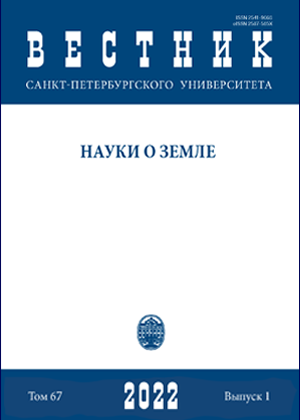Elk Island (Losinyi Ostrov) national park: transformation of regulations in urban environment
DOI:
https://doi.org/10.21638/spbu07.2022.110Abstract
To take into account both ecosystem and socio-economic functions, it is necessary to carry out functional zoning of specially protected natural areas (SPNA). The dynamics of zoning of the Losiny Ostrov National Park from 1988 to 2012 was assessed from the position of environmental regimes using open-access data. Using GIS technologies, the estimated dynamic schemes of environmental restrictions were obtained. The tendency to easing regulations clearly exists: the weighted average dynamic parameter of environmental value is -3.27 (possible values vary from -20 to 20). The 2012 version established stronger transformations of environmental restrictions than in 2010 (dynamic indicators are -0.62 and -2.65, respectively). The greatest negative changes for natural complexes are associated with the allocation of a historical and cultural zone, the transformation of third-party user sites into economic zones, the expansion of the recreational zone, and the disappearance of the educational and excursion zone. Differences between Moscow city and the adjacent Moscow region are negligible. However, there is considerable disparity between current zoning of urban and regional parts of the park (restriction indicators are 7.41 and 12.17, respectively). Urban space is more oriented towards recreation, indicating an incompatibility with the status of a national park. In contrast to the outer 1000-meter belt, the central part of the park has had greater deterioration of nature restrictions. The weighted average indicator of ecosystem compliance (environmental restrictions and vulnerability of natural complexes) is 3.3 (possible values range from -20 to 20), which points to a sufficient level of compliance with the functional zoning of landscape vulnerability. This accordance is more typical of inner part of the park inner and territories within the boundary of Moscow.
Keywords:
protected areas, green infrastructure, Elk Island, Moscow, urban ecology, spatial planning, zoning, geographic information systems
Downloads
References
Заиканов, В. Г., Киселева, В. В., Сависько, И. С. (2008). Определение оптимального режима использования территории национального парка «Лосиный остров» на основе геоэкологической оценки. Сергеевские чтения. Международный год планеты Земля: задачи геоэкологии, инженерной геологии и гидрогеологии. Материалы годичной сессии Научного совета РАН по проблемам геоэкологии, инженерной геологии и гидрогеологии. М.: Геос, 418–423.
Исполнительные комитеты Московского областного и Московского городского Советов народных депутатов (1979). Объединенное решение исполнительных комитетов от 04.05.1979 №1190-543. Москва. [online] Доступно на: https://losinyiostrov.ru/wa-data/public/site/documents/normativ/1979.05.04%20Решение%20исп.комитетов%20от%2004.05.1979%20№%201190-543.pdf [Дата доступа 03.03.2021]
Исполнительные комитеты Московского областного и Московского городского Советов народных депутатов (1988). Объединенное решение от 10.10.1988 №2130-1344. Москва. [online] Доступно на: https://docs.cntd.ru/document/456042915 [Дата доступа 03.03.2021]
Карта Московской области (1989) Московское аэрогеодезическое предприятие ордена Трудового Красного Знамени ГУГК СССР. М 1:200000, Москва.
Киселева, В. В. (2019). Динамика типов леса и типов насаждений национального парка «Лосиный остров». Лесной вестник, 2, 20–28. https://doi.org/10.18698/2542-1468-2019-2-20-28
Котов, С. Д. (2017). Взаимосвязь плотности застройки и устойчивости НП «Лосиный остров». Наука сегодня: реальность и перспективы: материалы Международной научно-практической конференции. Вологда: ООО «Маркер», 38–40.
Кочуров, Б. И., Ивашкина, И. В., Фомина, Н. В., Лобковская, Л. Г. (2018). Принципы и приемы развития современного города как сложной урбоэкосоциосистемы. Экология урбанизированных территорий, 3, 83–90.
Министерство природных ресурсов Российской Федерации (2002). Приказ министерства от 25.12.2002 №910. Москва. [online] Доступно на: http://publication.pravo.gov.ru/Document/View/0001202012210099 [Дата доступа 03.03.2021].
Министерство природных ресурсов Российской Федерации (2010). Приказ от 30.06.2010 № 232. Москва. [online] Доступно на: http://www.consultant.ru/cons/cgi/online.cgi?req=doc&base=EXP&n=527313&dst=100001 [Дата доступа 03.03.2021].
Министерство природных ресурсов Российской Федерации (2012). Приказ от 26.03.2012 № 82. Москва. [online] Доступно на: https://minjust.consultant.ru/documents/3130 [Дата доступа 03.03.2021].
Правительство Российской Федерации (2021). Проект постановления о расширении территории национального парка «Лосиный остров». [online] Доступно на: https://regulation.gov.ru/projects#npa=88375 [Дата доступа 03.03.2021].
Резников, А. И. (2014). Экспертная работа по подготовке аналитических материалов, необходимых для принятия решения о целесообразности установления дополнительных категорий особо охраняемых территорий регионального значения в Санкт-Петербурге. [online] Доступно на: https://grad-com.ru/assets/upload/fileattach/1095/ekspertnaya-rabota-oopt.pdf. [Дата доступа 15.10.2021].
Якубов, Х. Г., Самаев, С. Б., Семутникова, Е. Г., Абатуров, А. В. (2003). Комплексная оценка техногенного воздействия на Национальный парк Лосиный остров (1995–1997 гг.). Научные труды Национального парка Лосиный остров, вып. I. Москва: КРУК-Престиж, 111–126.
Bonham-Carter, G. F. (1994). Geographic Information Systems for Geoscientists: Modeling with GIS. Pergamon: Oxford, UK, 416 p.
Carreiro, Margaret M. and Zipperer, Wayne C. (2011). Co-adapting societal and ecological interactions following large disturbances in urban park woodlands. Austral Ecology. https://doi.org/10.1111/j.1442-9993.2010.02237.x
Europarc Deutschland (2012). Nationale Naturlandschaften. Evaluation of German National Parks. [online] Available at: http://www.europarc-deutschland.de/wp-content/uploads/2012/10/Evaluation-of-German-National-Parks.pdf [Accessed Feb. 12, 2021].
Kohler, B. (2017). Europarc Federation, WWF. Protection of Wilderness and Natural Processes in Austria. [online] Available at: http://www.europarc.org/wp-content/uploads/2017/05/Autria-01_Kohler-Austria.pdf [Accessed Feb. 12, 2021].
Openstreetmap.org (2021). Сайт картографического портала Open Street Maps. [online] Available at: https://www.openstreetmap.org [Accessed Feb. 12, 2021].
Pc.gc.ca (2019). Rouge National Urban Park Management Plan. [online] Available at: https://www.pc.gc.ca/en/pn-np/on/rouge/info/gestion-management/gestion-management-2019 [Accessed Oct. 15, 2021].
Rosreestr.ru (2021). Публичная кадастровая карта России. [online] Available at: https://pkk.rosreestr.ru/ [Accessed Feb. 12, 2021].
Sanparks.org (2015). Table Mountain National Park Management Plan. [online] Available at: https://www.sanparks.org/assets/docs/conservation/park_man/tmnp_approved_plan.pdf [Accessed Oct.15, 2021].
Zhu, X. (2016) GIS for Environmental Applications — A Practical Approach. (1 ed.). Routledge
Downloads
Published
How to Cite
Issue
Section
License
Articles of "Vestnik of Saint Petersburg University. Earth Sciences" are open access distributed under the terms of the License Agreement with Saint Petersburg State University, which permits to the authors unrestricted distribution and self-archiving free of charge.






